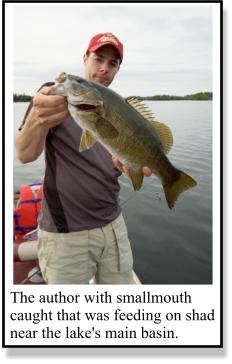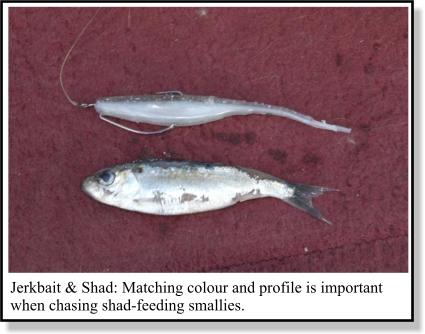
Click Here

Editors & Publishers
T.J. & Monique Quesnel
The
Ontario Fishing Network
E-Magazine is
published 12 times a year on or near the beginning of every month. Our
magazine is geared to any angler who enjoys fishing of any type in the
wonderfully diverse province of Ontario.
Editorial Submissions: We welcome query letters,
but assume no responsibility for unsolicited materials.
Subscriptions: Subscriptions are FREE of charge
and delivered via email. You can subscribe
HERE:
Privacy Policy: Unlike other publications We
NEVER make our subscribers list (your email address) available to any
other companies.
Advertising: If you are interested in advertising
please email us.
Circulation - 7,500 email subscribers
© 2007 Due North
Marketing / Ontario Fishing Network / T.J. Quesnel. All rights
reserved. Reproduction of any material without prior written
permission strictly prohibited.
|
Shad-Feeding Smallmouth Tactics
By Tim Allard
 When
shad school up in the summer over open, deep water areas, smallmouth
bass won't be far behind. For anglers who may wonder, "Why aren't
the smallies in the rocky shallows?" In many lakes I fish, the
answer is often that the bronzebacks are chasing schools of shad.
You can catch these roaming smallies with a variety of baits. Here's
how. When
shad school up in the summer over open, deep water areas, smallmouth
bass won't be far behind. For anglers who may wonder, "Why aren't
the smallies in the rocky shallows?" In many lakes I fish, the
answer is often that the bronzebacks are chasing schools of shad.
You can catch these roaming smallies with a variety of baits. Here's
how.
A Pack-Like
Mentality
Smallmouth will work in groups corralling and chasing shad over
deep water and main basin areas of a lake. They'll push shad to the
surface or against other structures (like a narrows or a reef) to
disorient and ambush their forage. During the chaos of the hunt,
you'll want to use fast moving baits. However, after the feeding
frenzy has subsided, working the same areas over with a slower
moving presentation can sometimes coax a few more fish to your boat
that were searching for remaining wounded shad.
Start With
Spinnerbaits
It's tough to beat a white, double willow leaf spinnerbait when
smallmouth are chasing shad. Use a heavy bait that's at least half
an ounce, so you can burn it in on a fast retrieve. The flash, thumb
and profile of these baits will often get smacked when smallies are
in the midst of the attack. Use a medium action rod. This way when a
smallmouth hammers the spinnerbait, the rod will have some give to
it so you'll get a good hook set.
Hard-Plastic
Jerkbaits
A second option instead of spinnerbaits are hard-plastic
jerkbaits. I like suspending models especially when working baits
over deep water, but floating baits are fine as well. When
smallmouth are aggressive, work these baits with a quick ripping
retrieve. Mix in a few pauses, but keep them short. As long as the
action's right, it's tough to work a bait too fast when smallies are
wound up. Smithwick's Suspending Rogues, Bagley's Bang-O-Lure or a
Cotton Cordell's Ripplin' Red Fin are three great jerkbaits/
Have a Throw-Back
Although the above two baits will often hook wound-up smallies, it's
wise to have a slower, soft-plastic presentation rigged and ready on
a nearby rod. Two classic throw-back and slower baits are wacky
worms and soft-plastic jerkbaits. Toss these baits at a following
fish that missed a fast-moving bait for a second chance at a strike.
Equally as effective is
casting a slow moving plastic to fish following a smallmouth your
partner has hooked. These baits are also great options to work over
an area after the smallmouth feeding frenzy has ended. You can often
pick up some less-aggressive bass scavenging for wounded shad.
Wacky Rigged Worms
Wacky rigged worms are often associated with largemouth bass,
but they work just as well for smallmouth. I've found them
particularly deadly over deep water flats and between islands for
smallmouth on lakes. I often have a white or pearl colored Senko
rigged on a small circle hook or a weighted, wacky hook. This bait
is one of my top throw-back lures or when looking for stragglers.
Soft-Plastic
Jerkbaits
Soft-Plastic jerkbaits are another great smallmouth bait. They
perform just as well over shallow, rocky areas as they do over deep
water. A soft-plastic rigged on a wide gap, weighted hook can be
brought in on a fast retrieve when smallies are feeding
aggressively.

Alternatively, they are
equally as effective for a subtle and slow presentation. It's good
practice to match the colour of the bait to shad. This means a white
base with light blue, silver, black or green as the secondary
colors. It's critical to use low-stretch, sensitive line like braid
to detect hits when working baits with small twitches and long
pauses. Some proven soft-plastic jerkbaits include: Strike King's Z
Too, Set the Hook's Salty Shad, Mann's HardNose Jerkbait, and
Gambler's Flappin' Shad.
Try the above baits to
chase smallmouth bass that are feeding on shad. Use fast moving
lures when the action is hot, and switch to a slower moving
presentations when the feeding frenzy has subsided to fool the
stragglers. Dawn and dusk are prime times to find smallies targeting
shad, but keep your eyes peeled during the day. Surface splashing or
bird activity over the lake's main basin are signs that smallies
might be feeding on shad.
|